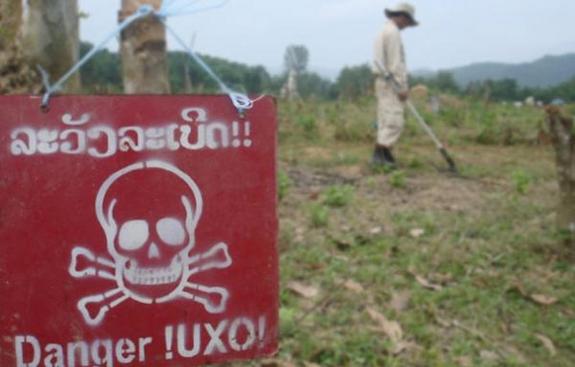Soldiers from the Lao People’s Army have been deployed to clear unexploded ordnance (UXO) along the route earmarked for the Laos-China railway so that construction of the track can begin.
An official ceremony to launch the deployment of the UXO clearance teams took place on Wednesday at the Ministry of National Defence.
Minister of National Defence, Lieutenant General Chansamone Chanyalath, Minister of Public Works and Transport, Dr Bounchanh Sinthavong, and other officials attended the ceremony.
The UXO dropped during the Indochina war remains a contaminant in provinces across Laos including along the planned railway, which will connect Vientiane with the Chinese border.
The deployment ceremony came after an official ceremony was held last month in Luang Prabang province to launch the construction of the US$5.8 billion railway.
Deputy Chief of the General Staff Department, Brigadier General Khamlieng Outhakaisone, who is head of the committee in charge of UXO clearance, told ceremony participants that six clearance units have been assigned to clear UXO in six segments of the 417km rail track. UXO detectors, vehicles and other equipment have been prepared to carry out the work.
Speaking at the ceremony, Lieutenant General Chansamone called for the soldiers to work their hardest to fulfill the tasks they are assigned to ensure the safety of the project and enable construction to be completed in line with the set time frame.
It will take five years to complete the project, meaning that the railway is set to be fully complete by the end of 2021 following the launch of construction last month.
Six Chinese contractors are carrying out construction in the six segments along the entire track, which comprises 167 bridges with a total length of 61.81km, 75 tunnels with a combined length of 197.83km, and 32 stations including 21 stations where two trains can pass.
Ground works have begun for the construction of the rail track that will run through the provinces of Luang Namtha, Oudomxay, Luang Prabang and Vientiane, linking to the nation’s capital.
In Luang Namtha alone, more than 1,000 Lao and Chinese workers have been stationed and are carrying out work there, according to provincial authorities in charge of project coordination.
Some 70 percent of the project’s total investment cost is financed by China, while Laos will be responsible for the remainder.
The trains are designed to travel at a speed of 160km per hour in mountainous areas and 200km per hour in flat land areas, while freight trains will be limited to 120km an hour.
Source: Vientiane Times



